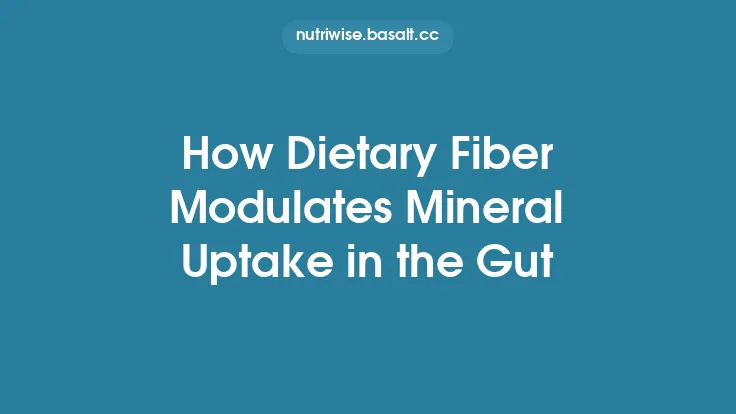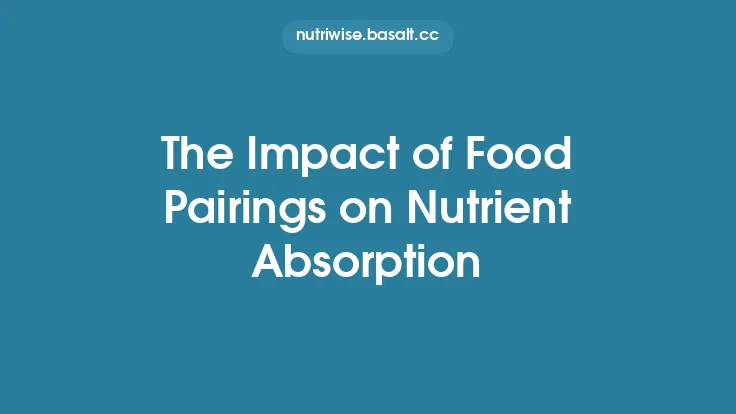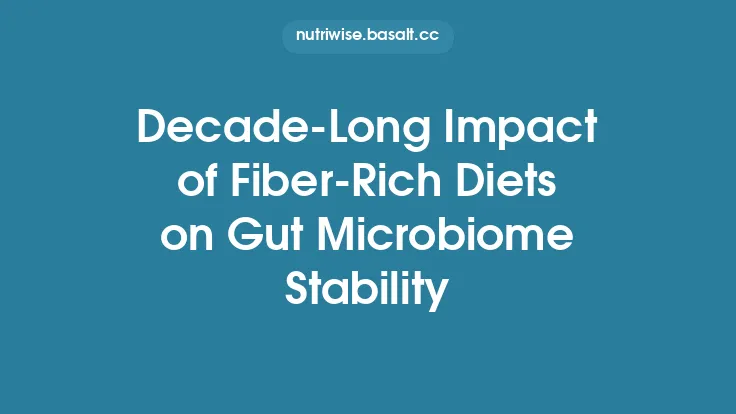Dietary fiber is often celebrated for its beneficial effects on gut health, yet its influence on nutrient uptake extends beyond the realm of microbiome modulation. While the microbial community in the colon plays a pivotal role in fermenting fiber into short‑chain fatty acids, a substantial body of research demonstrates that fiber can alter the absorption of macronutrients and micronutrients through purely physicochemical mechanisms. Understanding these pathways is essential for nutrition scientists, dietitians, and anyone interested in optimizing the nutritional value of meals without relying on changes in the gut microbiota.
Understanding Dietary Fiber: Classification and Physicochemical Traits
Fiber is a heterogeneous group of plant‑derived carbohydrates that resist digestion by human brush‑border enzymes. Its classification is traditionally based on solubility, but a more functional approach considers molecular weight, degree of polymerization, branching pattern, and water‑binding capacity.
| Category | Typical Sources | Key Physicochemical Features |
|---|---|---|
| Soluble, Viscous Fibers | β‑glucan (oats, barley), pectin (citrus, apples), guar gum, psyllium | Form gels in aqueous environments; high viscosity; can trap nutrients within a hydrated matrix. |
| Soluble, Non‑Viscous Fibers | Inulin, fructooligosaccharides (FOS), resistant starch type 2 | Dissolve readily; limited gel formation; primarily affect osmotic balance. |
| Insoluble Fibers | Cellulose (whole grains, vegetables), lignin, hemicellulose | Low water solubility; increase fecal bulk; accelerate intestinal transit. |
| Hybrid Fibers | Wheat bran (mix of cellulose, hemicellulose, lignin), oat bran | Exhibit both bulking and modest gel‑forming properties. |
These intrinsic properties dictate how fiber interacts with the luminal environment, influencing diffusion rates, surface contact with the epithelium, and the physical accessibility of nutrients.
Mechanistic Pathways Linking Fiber to Nutrient Uptake
Viscosity and Diffusion
Viscous soluble fibers dramatically increase the thickness of the unstirred water layer (UWL) that lines the intestinal mucosa. The UWL acts as a diffusion barrier; a thicker layer slows the movement of nutrients from the lumen to the absorptive surface. The relationship can be expressed by Fick’s first law:
\[
J = -D \frac{dC}{dx}
\]
where \(J\) is the flux, \(D\) the diffusion coefficient, and \(\frac{dC}{dx}\) the concentration gradient. An increase in viscosity reduces \(D\), thereby lowering the flux of glucose, amino acids, and fatty acids. This effect is independent of microbial fermentation and can be observed within minutes of fiber ingestion.
Gel Formation and Barrier Effects
When soluble fibers such as β‑glucan hydrate, they create a three‑dimensional gel network that physically entraps nutrients. The mesh size of the gel determines which molecules can diffuse freely. Small sugars may still permeate, whereas larger lipid micelles or protein fragments experience steric hindrance. The gel also reduces the effective surface area of the intestinal lumen exposed to nutrients, further limiting absorption.
Electrostatic Interactions and Mineral Binding
Many fibers possess charged functional groups (e.g., carboxyl groups in pectin, phenolic hydroxyls in lignin). These groups can chelate divalent cations such as calcium, iron, and magnesium through ionic or coordination bonds. The binding affinity is a function of the fiber’s charge density and the ionic strength of the intestinal contents. Importantly, this chelation occurs in the lumen before any microbial metabolism, directly decreasing the free mineral pool available for transport via channels like TRPV6 (calcium) or DMT1 (iron).
Modulation of Intestinal Transit
Insoluble fibers increase fecal bulk and stimulate peristalsis, shortening the residence time of nutrients in the small intestine. A reduced contact time limits the window for carrier‑mediated uptake, especially for nutrients that rely on active transport (e.g., certain amino acids and vitamins). Conversely, highly viscous soluble fibers can slow gastric emptying and small‑intestinal transit, sometimes enhancing the exposure of nutrients to absorptive sites. The net effect on uptake depends on the balance between bulk‑induced acceleration and viscosity‑induced deceleration, both of which are independent of microbial activity.
Evidence from Human and Animal Studies Isolating Microbiome‑Independent Effects
Germ‑Free and Antibiotic‑Treated Models
- Rodent Studies: Germ‑free mice fed a diet enriched with 5 % β‑glucan displayed a 20 % reduction in post‑prandial glucose excursions compared with germ‑free controls on a fiber‑free diet. Because these animals lack a functional microbiota, the effect is attributed solely to the viscous barrier created by the fiber.
- Antibiotic Trials: In a crossover study, healthy adults received a high‑viscosity oat fiber supplement for 48 hours while concurrently taking a broad‑spectrum antibiotic regimen that suppressed colonic fermentation. Plasma triglyceride responses to a standardized fat load were attenuated by ~15 % relative to the control period, indicating that the fiber’s impact on lipid absorption persisted despite microbiome suppression.
Short‑Term Human Interventions
Acute feeding trials (single‑meal designs) are valuable because they limit the time for microbial adaptation. In a double‑blind study, participants consumed a glucose drink with or without 3 g of soluble corn fiber. The fiber‑co‑ingested condition produced a lower glycemic index without measurable changes in fecal short‑chain fatty acid concentrations, confirming a microbiome‑independent mechanism.
In‑Vitro Digestion Systems
Dynamic gastrointestinal simulators (e.g., TIM‑1) replicate human digestion without any microbial component. When soluble fibers were introduced into the simulated duodenal compartment, the measured dialysate concentrations of calcium and iron decreased by 12–18 % relative to fiber‑free runs. These reductions were directly linked to fiber‑nutrient complex formation observed via spectroscopic analysis.
Collectively, these experimental approaches converge on the conclusion that dietary fiber can modulate nutrient uptake through physical and chemical interactions that do not require alterations in the gut microbiome.
Implications for Specific Nutrient Classes
Carbohydrates and Simple Sugars
Viscous fibers slow the diffusion of glucose and fructose, flattening post‑prandial glucose peaks. The effect is most pronounced when fiber is consumed concurrently with the carbohydrate source, as the gel forms around the sugar molecules before they can be absorbed.
Lipids and Fat‑Soluble Vitamins
The gel matrix can sequester bile salts and micellar structures, reducing the solubilization of triglycerides, cholesterol, and fat‑soluble vitamins (A, D, E, K). Studies using radiolabeled cholesterol have shown a 10–15 % decrease in intestinal absorption when participants ingested 10 g of psyllium alongside a high‑fat meal.
Minerals
- Calcium: Pectin and phytate‑rich fibers bind calcium ions, forming insoluble complexes that are not readily taken up by the calcium‑sensing receptor (CaSR).
- Iron: The chelation of ferric iron by phenolic groups in lignin reduces its availability for DMT1 transport.
- Magnesium and Zinc: Similar binding patterns have been observed, though the magnitude of inhibition varies with fiber type and dietary mineral load.
Water‑Soluble Vitamins
Because many water‑soluble vitamins (e.g., B‑complex, vitamin C) are small, uncharged molecules, they are less affected by steric hindrance but can be diluted within the viscous phase, leading to modest reductions in absorption efficiency.
Amino Acids and Peptides
Proteins that are hydrolyzed into peptides may become entrapped within the fiber gel, limiting their contact with peptide transporters (e.g., PEPT1). In vitro studies have reported a 5–8 % decrease in dipeptide uptake when soluble fibers are present at concentrations typical of a high‑fiber diet.
Practical Considerations for Dietary Planning
- Timing of Fiber Intake
- Concurrent Consumption: To attenuate rapid glucose spikes, pair soluble viscous fiber with carbohydrate‑rich foods.
- Separate Meals: If the goal is to maximize mineral absorption (e.g., calcium from dairy), schedule high‑fiber foods at least 30 minutes apart from the mineral source.
- Choice of Fiber Type
- Viscous Soluble Fibers (β‑glucan, psyllium) are most effective for modulating carbohydrate and lipid uptake.
- Insoluble Fibers (cellulose, wheat bran) primarily influence transit time and have a milder impact on nutrient binding.
- Dosage
- Moderate intakes (3–5 g of soluble viscous fiber per meal) produce measurable effects without causing excessive gastrointestinal discomfort.
- Exceeding 15 g per meal may lead to nutrient malabsorption and should be approached cautiously, especially in populations with higher micronutrient needs (e.g., pregnant women, athletes).
- Food Matrix Interactions (Limited Scope)
- While the broader food matrix can affect fiber functionality, focusing on the fiber’s intrinsic properties (solubility, viscosity) provides a more predictable outcome for nutrient uptake.
Potential Risks and Mitigation Strategies
- Nutrient Deficiencies: Chronic high intake of binding fibers may contribute to suboptimal mineral status. Periodic assessment of serum calcium, iron, and magnesium is advisable for individuals consuming >30 g of binding fiber daily.
- Gastrointestinal Symptoms: Rapid increases in fiber can cause bloating, flatulence, and altered stool consistency. Gradual titration and adequate hydration (≥2 L water per day) mitigate these effects.
- Medication Interference: Certain fibers can impede the absorption of oral medications (e.g., levothyroxine). Scheduling medication intake at least one hour before or two hours after high‑fiber meals reduces this risk.
Future Research Directions
- High‑Resolution Imaging of Fiber‑Nutrient Interactions
- Techniques such as cryo‑electron microscopy and synchrotron X‑ray tomography could visualize the spatial distribution of nutrients within fiber gels in real time.
- Molecular Modeling of Binding Affinities
- Computational docking studies can predict the strength of mineral–fiber complexes, guiding the design of fiber blends with tailored binding capacities.
- Personalized Nutrition Platforms
- Integrating individual genetic markers of nutrient transporters (e.g., SLC34A1 for phosphate, SLC5A1 for glucose) with fiber intake data may allow customized recommendations that balance the benefits of fiber with optimal nutrient absorption.
- Engineered Fibers
- Emerging biotechnologies enable the production of fibers with controlled molecular weight and charge density, offering the possibility to fine‑tune their impact on specific nutrients without affecting the microbiome.
- Longitudinal Cohort Studies
- Observational studies tracking dietary fiber patterns, nutrient status biomarkers, and health outcomes over decades will clarify the long‑term implications of microbiome‑independent fiber effects.
In summary, dietary fiber exerts a multifaceted influence on nutrient uptake that extends beyond its well‑known role in shaping the gut microbiome. By altering luminal viscosity, forming physical barriers, binding minerals, and modulating transit time, fiber can either impede or, in certain contexts, enhance the absorption of macronutrients and micronutrients. Recognizing these mechanisms empowers nutrition professionals to harness fiber strategically—optimizing metabolic responses, supporting mineral balance, and tailoring dietary patterns to individual health goals—while remaining mindful of potential trade‑offs and the need for continued research.





